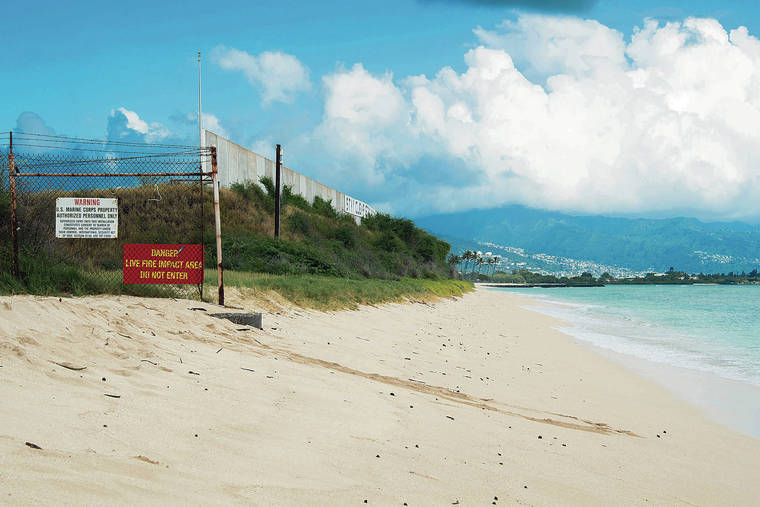The U.S. Marine Corps presence on the Ewa Beach shoreline dates back to 1915, when it established pistol and rifle ranges along with a tent camp for officers and enlisted service members at Puuloa Range Training Facility.
The century-long residence should foster an all-inclusive appreciation of area civilian concerns. But a current push — despite neighborhood anxiety — to install a 1,500-foot barrier against oceanfront erosion at the training facility suggests the Marines are falling short of good neighbor, good environmental-steward status.
The plan calls for driving “sheet pile,” likely made of steel, into grounds along the makai boundaries of long-distance ranges; and would relocate short-distance ranges about 100 feet inland. In an environmental assessment (EA), the Marines concluded that such a shield would deliver “no significant impact” on the beach ecosystem.
Some Ewa Beach residents, who rightly suspect otherwise, are circulating a petition asking for a more in-depth environmental impact statement (EIS). Also adding pressure is U.S. Sen. Brian Schatz, who this week requested study of other options to ensure alignment with “best practices for coastal zone management and beach erosion.”
Still, there’s little in way of government authority to force further study of the plan for what is essentially a sea wall, a hardening of shoreline — short of the filing of a lawsuit in federal court. But it really shouldn’t come to that. Out of respect for the training facility’s neighbors and Hawaii’s future-focused environmental concerns, the Marines should comply with the requests.
This summer — shortly before the Marines released the EA for shoreline stabilization — Gov. David Ige signed off on updated rules for EA and EIS documents, which developers and government agencies draft to assess impacts of a planned development or activity on an area.
Among the new aims is to view environmental analysis through the lens of sustainability — immediate land and water impacts as well as outlooks, such as those examined by the Hawaii Climate Commission. About 70% of the state’s beaches are eroding, and global warming is expected to make matters worse.
In many cases, armoring of shoreline has touched off beach loss downstream. Erecting more walls in an attempt to save public, private and government property could result in more miles of Hawaii beaches forever lost.
On either side of the training facility is Puuloa Beach Park and Kapilina Beach Homes, formerly Iroquois Point. While the Corps intends to bury much of the barrier, with only about 1 foot visible, residents worry that waves could eventually expose a much larger section of the wall, touching off downstream damage.
In a letter to Marine Corps Commandant Gen. David Berger, Schatz suggested weighing natural design principles tapped for other climate-related mitigation projects, such as artificial reefs. Such a fix is worth exploring. Scientists say that coral reefs — acting as submerged breakwaters — are responsible for dissipating up to 97% of wave energy offshore.
In addition to a wall, the project also includes a strip of erosion-blocking revegetation. Among alternative plans considered and discarded in the EA process: re-vegetation alone, or moving all range components back from the shoreline.
Just vegetation is likely a flimsy Band-Aid. And the Corps opposed the full retreat move, citing potential high cost and disruption of operations. However, in the long term, relocation could yield cost savings, as the safest bet for protection from an ocean-fueled erosion threat is to pull up stakes and head inland.
The Marines need to pause, not rush into this barrier project as soon as funding becomes available. Commit to finding a way to balance training range viability with natural resources stewardship and neighborhood harmony.

